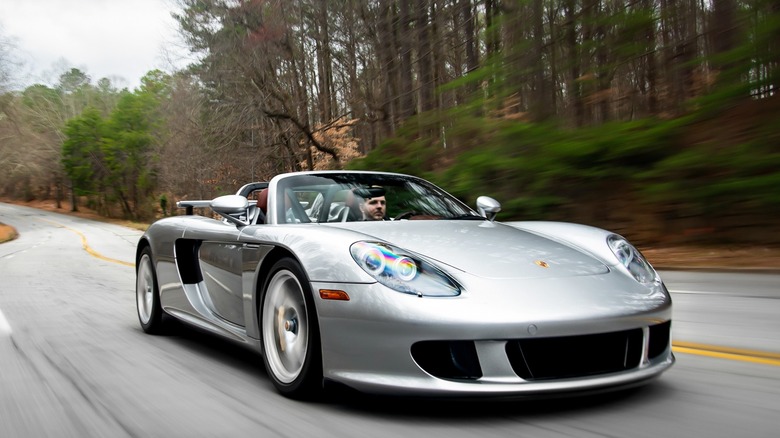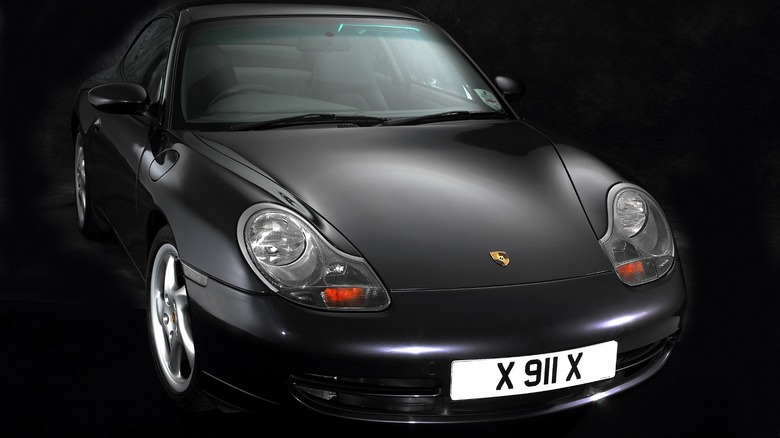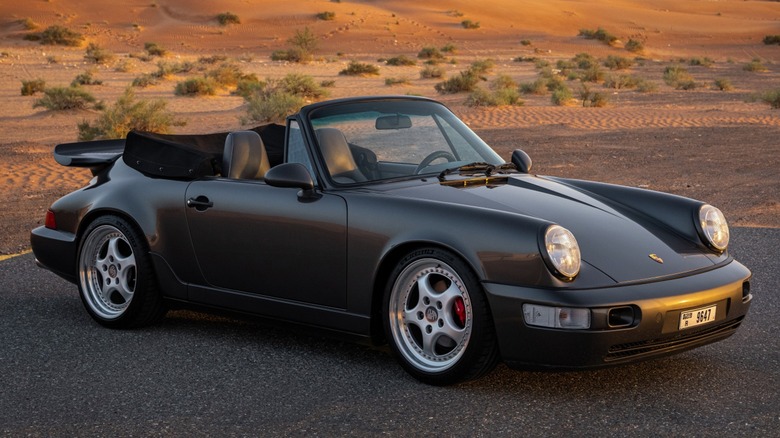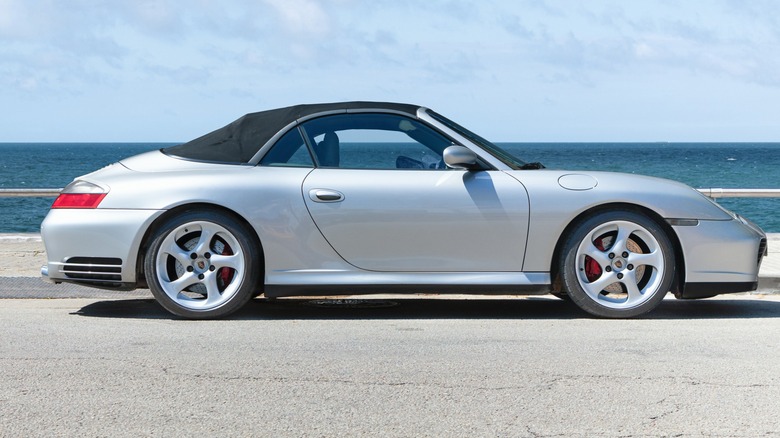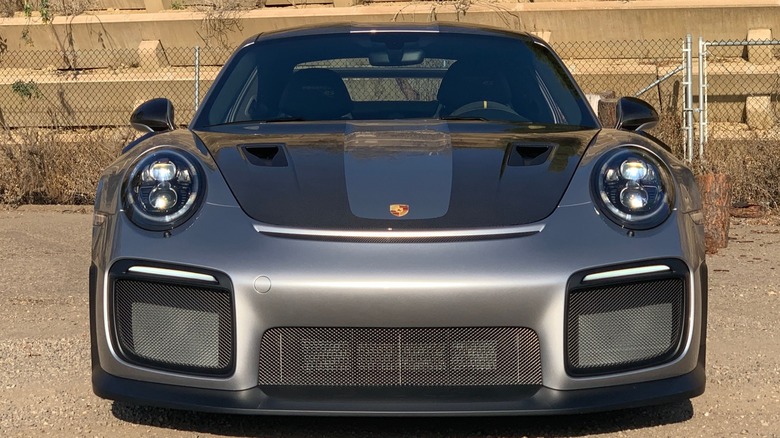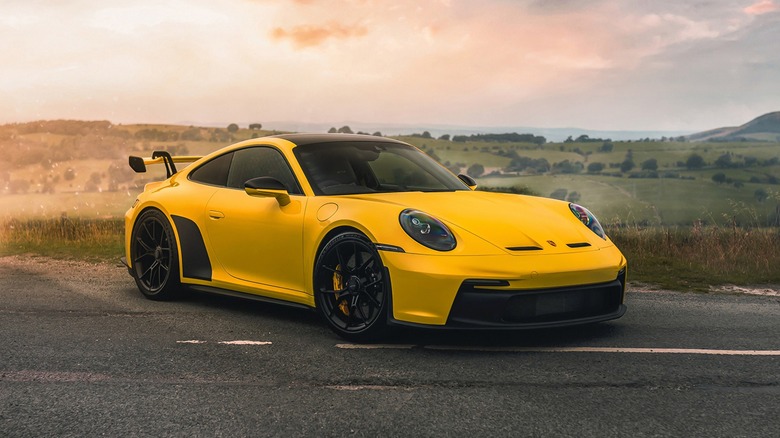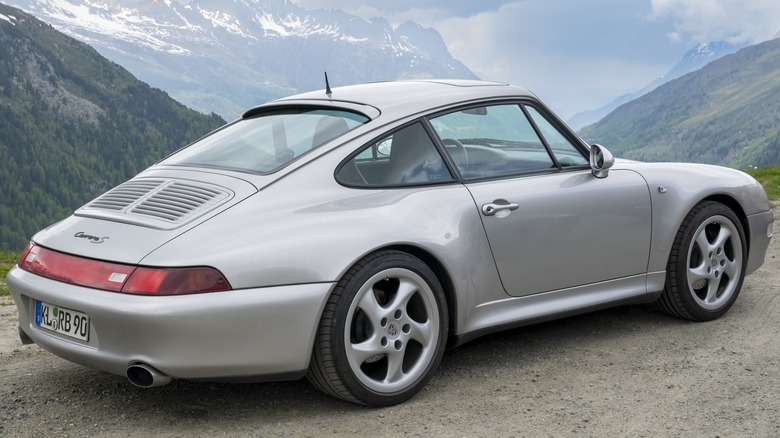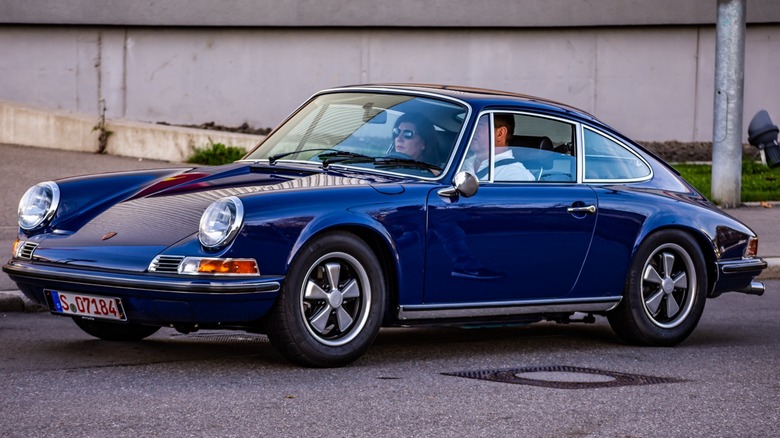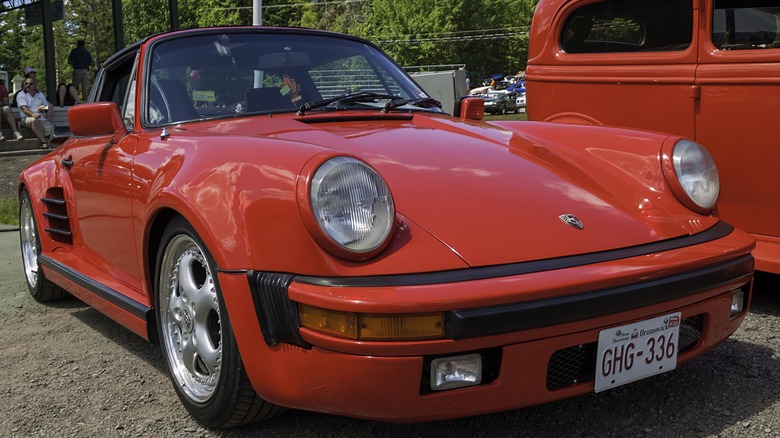Every Porsche 911 Generation Ranked Worst To Best
The Porsche 911 has evolved over 60 years from the Porsche 356 introduced in 1963 and its humble roots as the descendant of Ferdinand Porsche's first Volkswagen to the current 992 models, engineering masterpieces loaded with modern technology. For eight generations, the 911 has been the high-performance sports car benchmark by which all others are measured. While the basic 911 shape has remained constant, the 911 has undergone countless updates keeping it at the forefront of automobile technology and performance.
Many Porsche production car innovations came from its special edition series and racing experience. Some of these include:
- Turbocharging: Porsche was a forerunner in adapting the turbocharger to various driving states. The automaker implemented exhaust-side charge pressure control as an alternative to more conventional intake-side control. It recently patented an even more powerful and efficient turbocharger.
- Internally ventilated disc brakes: In 1966, Porsche introduced internally ventilated discs to the 911 S to improve braking stability and efficiency at high speeds.
- All-wheel drive (AWD): With experience from the Type 959 featuring innovative technology such as an active suspension and a sequential twin-turbocharged engine, Porsche implemented all-wheel drive in its production 911 in 1988.
- Seven-speed manual gearbox and PDK (Porsche Doppelkupplung) transmission: The double-clutch transmission provides both smooth and sporty shifting.
Here's how the eight generations of the Porsche 911 rank, from worst to best (although even the worst generations outclassed most other high-performance cars on the market at the time).
Porsche 996 (1998–2004)
The Porsche 996 makes the top of the worst-to-best Porsches list that includes some of the finest sports cars ever made. Although the 996 generation produced some exceptional high-performance vehicles, it was troubled by several issues, the most critical being an IMS bearing failure that impacted a small percentage of naturally aspirated models. Two other issues were exaggerated by buyer perception. The 911 used the first very first water-cooled engine (considered a sacrilege to Porsche purists), and "egg-shaped" headlights were not favored by some Porsche enthusiasts.
The early 996 models, introduced in 1997, came in a rear-wheel-drive Carrera coupe or cabriolet. Porsche introduced several upgrades to the water-cooled, naturally aspirated 3.4-liter flat-six engine, including cylinder heads with four valves that operated with variable valve timing, a redesigned variable resistance intake system, and integrated dry-sump oiling. The engine produced 296 horsepower and 258 pound-foot of torque while reducing emissions, engine noise, and fuel consumption over previous versions. The 1997 911 Carrera accelerated from 0 to 60 mph in 4.6 seconds, reached the quarter mile in 13.0 seconds and achieved a top speed of 175 mph.
The wider stance 996 Turbo, fitted with a twin-turbocharged and intercooled 3.6-liter engine, generated 415 horsepower and 415 pound-foot of torque. Power was sent to all four wheels via a six-speed manual or a five-speed Tiptronic automatic transmission. The Turbo accelerated to 60 mph in a mere 3.9 seconds and reached the quarter mile in 11.9 seconds at 116.2 mph on its way to the top speed of 194 mph.
Porsche 964 (1989–1994)
Porsche introduced the 964 in 1989, utilizing new technology, claiming that 85% of the sports car had been redesigned. Externally, the 964 maintained the same 911 body style as the previous generation except for the addition of aerodynamic polyurethane bumpers and changes to the rear spoiler. Porsche smoothed out the bodywork and reduced the drag coefficient to 0.32Cd by removing the "whale tail" common on the 1980s 911 models (except the Turbo), replacing it with an automatically extending rear spoiler.
Improvements to handling were achieved by swapping out the older torsion bar suspension of the original 911 with a new Porsche trailing arm "Weissach" rear axle design, adding self-steering elements to reduce oversteer and improve road-holding characteristics. The 964 model was the first 911 to offer an automatic transmission with the four-speed "Tiptronic," power steering, ABS, dual-mass flywheel, power steering as standard, dual front airbags, and all-wheel drive (in the Carrera 4 model).
The 1990 Porsche 911 four-wheel-drive Carrera 4, equipped with a 3.6-liter boxer engine generating an impressive 247 horsepower at 6100 rpm and 228 pound-foot of torque at 4800 rpm, reached 60 mph in 5.1 seconds on its way to a top speed of 157 mph. Porsche also offered the 964 in a turbo version. However, instead of turbocharging the 3.6-liter engine installed in the Carrera 4, the automaker pulled the 3.3-liter Turbo from the 930. The Turbo produced 322 horsepower at 5750 rpm and 332 pound-foot of torque at 4500 rpm, accelerated to 60 mph in 4.0 seconds, and reached a top speed of 174 mph.
Porsche 997 (2005–2011)
Porsche offered the 997-generation 911 in a variety of trim levels, including Cabriolet, Turbo, Targa, Carrera, GTS, GT, and 911 speedster resembling the iconic Porsche 356 version. The 997 generation included a two-door coupé, two-door convertible, two-door Targa top, and two-door speedster. The combination of body styles and performance represented over 24 models, helping make the Porsche 997 the best-selling generation of 911 to date.
To differentiate Porsche trim levels, the automaker offered several engine displacements: The 2011 base model Carrera, Targa 4, and Carrera 4 were equipped with a 3.6-liter boxer engine good for 345 horsepower and 288 pound-foot of torque, while the S trims got a larger 3.8-liter unit with 385 horsepower and 310 pound-foot of torque. Porsche also offered the X51 Powerkit for S, 4S, and Targa models, which increased engine power.
The GTS trim produced 408 horsepower. Porsche provided two transmission options for all 997 models: A six-speed manual and a seven-speed PDK (Porsche Doppelkupplung) double-clutch transmission with paddle shifters. Buyers reported the paddles enabled seamless shifting, ranking the gearbox among the best available on a road car during the 997 generation years.
According to Car and Driver, the 2005 Porsche 911 Carrera S with the DOHC 24-valve 3.8-liter flat-six featuring an aluminum block and heads with port fuel injection accelerated to 60 mph in 4.1 seconds, reached the quarter mile in 12.6 seconds at 112 mph, and achieved a top speed of 170 mph. The higher-performance 2010 Porsche 911 Turbo equipped with the 3.8-liter, 493-horsepower twin-turbo, and seven-speed twin-clutch automatic transmission accelerated to 60 mph in a blistering 3.4 seconds.
Porsche 991 (2011–2019)
The Porsche 991 is a high-performance, technology-filled sports car with all the power and road handling an enthusiast could desire while remaining an easy-to-control vehicle in a traffic-laden daily commute. The 2017 Carrera PDK with a twin-turbocharged and intercooled DOHC 24-valve flat-six generates 370 horsepower at 6500 rpm and 331 pound-foot of torque at 1700 rpm. Car and Driver tests showed an acceleration to 60 mph in a mere 3.4 seconds.
While the "standard" trims compete with some of the best-performing sports cars on the market, the special edition models are standouts. Porsche built only 1,948 special edition Speedsters. The convertible offered exceptional performance in a 911 R body style with a signature double-bubble faring behind the front seats.
The 4.0-liter flat-six produces 502 horsepower and 346 pound-foot of torque and accelerates the Porsche 911 Speedster from 0 to 60 mph in under 3.8 seconds. And it does so without many of the enhancements that characterize modern-day high-performance sports cars. The convertible lacks a turbocharger, a dual-clutch transmission, and all-wheel drive found on most supercars.
As impressive as the acceleration is, the exceptional handling may be better. The Speedster shares an adjustable sports suspension, torque vectoring system, and four-wheel steering with the 911 R. Writing in Motor Trend, Jade Nelson wrote: "My dropping jaw bruised my sternum as I took my first flat-out corner... The car felt at home on a tire-screeching, ultra-tight, increasing radius, double black diamond of a corner. As if it were built for that moment."
Porsche 992 (2019–present)
The evolution of any automobile usually includes performance upgrades, driver and passenger comfort enhancements, and styling improvements. The Porsche 992 is the latest in a long line of outstanding Porsche 911 automobiles and is no exception. A wide range of 992 models (11 trim levels) is available, including the base model Carrera, the S, 4, and 4S Carrera variants, the Targa 4 and Targa 4S, Turbo, Turbo S, GTS, Sport Classic, and GT3. Porsche also offers the Carrera, GTS, and Turbo trims in a convertible configuration.
Multiple powertrains are offered across the 11 trims. The naturally aspirated engines generate between 380 and 450 horsepower, while a turbocharged model can produce up to 641 horsepower. All the 911s are equipped with one of two transmission options: An eight-speed PDK dual-clutch automatic and a seven-speed manual gearbox.
The Porsche 911 Turbo and Turbo S are perhaps the signature cars in the 992 series. Equipped with a 3.7-liter flat-six engine mated to an eight-speed automatic gearbox and standard all-wheel drive, the Turbo generates 572 horsepower, and the S variant produces over 640 horsepower and 590 pound-foot of torque.
All that power pushes the Turbo S to 60 mph in less than 2.2 seconds on its way to a top speed of 205 mph. If that mind-boggling performance is insufficient, Porsche offers an optional lightweight package to compete with most exotic supercars. The Turbo S rockets to 60 mph in a blistering 2.1 seconds and reaches the quarter-mile mark in a mere 9.9 seconds.
Porsche 993 (1995–1998)
Porsche made significant improvements to the 911 with the release of the 993 in 1995. Only 20% of the components carried over from the previous generation. While the new 911 retained its general well-known shape on the outside, refinements to the body gave it a low-slung streamlined appearance, smoother and wider than the previous 964. The Porsche 993 also featured a newly engineered chassis and drivetrain. The automaker reduced the weight with an all-aluminum subframe and multilink rear suspension, engine modifications, and alloy hollow spoke wheels.
The base model 911, with its naturally aspirated air-cooled flat-six, produced 270 horsepower at 6100 rpm and 243 pound-foot of torque at 5000 rpm. The 911 Carrera 2S coupe generated 285 horsepower, accelerated to 60 mph in 5.4 seconds, and reached a top speed of 163 mph. However, the star of the 993 models was the 911 Turbo, featuring twin turbos and producing 400 horsepower. The 3.6-liter flat-six, an all-wheel drive gleaned from the 959 supercar, and a six-speed manual gearbox and a dual-flow exhaust helped accelerate the car to 60 mph in 3.8 seconds, reach the quarter mile in 12.2 seconds, and achieve a top speed of 180 mph.
Many special editions were made of the 993; the most notable is the 911 GT2 (1995 to 1997). Built to meet GT2 class racing requirements prohibiting all-wheel-drive vehicles, the GT2 weighed 400 pounds less than the 911 Turbo. It was the fastest version of the last era of air-cooled 911s producing 430 horsepower and 457 pound-foot of torque. Porsche made only 194 street version GT2 cars.
Porsche 911 Classic (1963–1972)
The classic 911 deserves a spot near the top of any "best" Porsche generation list, mainly because it is the original that started a 60-year history of excellent sports cars. Hemmings says, "...the Porsche brand has long stood for pure engineering and technological magnificence, as Ferdinand and Ferry Porsche would have it."
By today's standards, the first 911 was slow with poor handling, but the upside bathtub shape offered simple yet elegant looks, the characteristic Porsche exhaust note from a flat-six boxer engine, and the steering feel of a race car. Evolved from its predecessor, the 356, the 911 had a longer wheelbase, an improved compact suspension, and more power.
The original 911 was powered by a 2.0-liter H6 air-cooled flat-six producing a weak 148 horsepower and 140 pound-foot of torque. According to Automobile Catalog, the original 911 accelerated from 0 to 60 in 8.3 seconds, almost a second slower than the 2023 Honda Civic turbocharged Touring sedan.
The first half of the first generation 911 saw the introduction of the 912; the four-cylinder 912 was introduced to bridge the gap between the outgoing 356 and the 911 at a lower price point. Perhaps the most impressive upgrade was the 911S, released in 1966, boasting a 2.0-liter flat six-cylinder generating 160 horsepower at 6,600 rpm and 132 pound-foot of torque at 5,200 rpm. Weighing only 2,365 pounds, the sports car accelerated to 60 mph in 7.4 seconds and reached a top speed of 141 mph.
Porsche G-Series (1973–1989)
The first-generation Porsche 911 spanned 24 years, but most historians claim the G-Series was a significant enough upgrade that the 1973–1989 models should be considered a part of a new generation. The new 911 design included a raised bumper with black plastic bellows — required to meet American crash test standards — among other cosmetic changes. To satisfy American regulators, Porsche added safety features to the G-Series 911, including three-point safety belts and seats with integrated headrests.
While the second half of the first generation provided the Carrera, replacing the SC, and the cabriolet, the first convertible 911 version, the introduction of the 930 Turbo made the G-Series Porsche generation the best on the list. Introduced with a 3.0-liter H6 engine in 1974, four years later, the 930 Turbo boasted a 3.3-liter intercooled SOHC 12-valve air-cooled flat-six fitted with a KKK turbocharger capable of 90,000 rpm generating 11.4 psi of pressure.
Technology from the track included a wastegate to limit boost, an intercooler, and port fuel injection. The powerplant was built with an aluminum block and heads and mated to an aluminum box four-speed manual transmission. Porsche also upgraded the 930 with anti-roll bars, larger cross-drilled brake rotors, a robust suspension, new tires, and wheels.
When the 930 was introduced, it was the fastest German production car. Car and Driver test results showed the Porsche accelerating to 60 mph in a blistering 4.9 seconds, to 100 mph in 12.1 seconds, and reaching the quarter mile in 13.7 sec at 104 mph on its way to a top speed of 165 mph.
